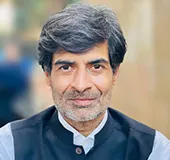Introduction
Public infrastructure has been a cornerstone of human progress. From the transcontinental railways of the nineteenth century to telecommunication in the twentieth century, infrastructure has been vital to facilitating the flow of people, money and information. Built on top of public infrastructure, democratic countries with largely free markets have fostered public and private innovation and, therefore, generated considerable value creation in societies.
In the twenty-first-century, technological innovation has created a tempest of ideological, geographical and economic implications that pose new challenges. The monopolisation of public infrastructure, which plagued previous generations, has manifested itself in the centralised nature of today’s digital infrastructure. It is increasingly evident that the world needs a third type of public infrastructure, following modes of transport such as ports and roads, and lines of communication such as telegraph or telecom – but with open, democratic principles built in.
Digital Public Infrastructure (DPI) can fulfil this need, though it faces several challenges. There is a disturbing trend of the weaponisation of data and technology – or “Digital Colonisation” – resulting in a loss of agency, sovereignty and privacy. Therefore, proactively deliberating on how to build good DPI is key to avoiding such challenges.
The monopolisation of public infrastructure, which plagued previous generations, has manifested itself in the centralised nature of today's digital infrastructure.
To begin with, it is important to crystallise what DPI is and what it does. Put simply, foundational DPIs mediate the flow of people, money and information. First, the flow of people through a digital ID System. Second, the flow of money through a real-time fast payment system. And third, the flow of personal information through a consent-based data sharing system to actualise the benefits of DPIs and to empower the citizen with a real ability to control data. These three sets become the foundation for developing an effective DPI ecosystem.
India, through India Stack, became the first country to develop all three foundational DPIs: digital identity (Aadhar), real-time fast payment (UPI) and a platform to safely share personal data without compromising privacy (Account Aggregator built on the Data Empowerment Protection Architecture or DEPA) (Roy, 2020). Each DPI layer fills a clear need and generates considerable value across sectors.
However, like in the case of physical infrastructure, it is important that DPIs not succumb to monopolisation, authoritarianism and digital colonisation. This can only happen through a jugalbandi (partnership) of public policy and public technology, i.e., through a techno-legal framework. Techno-legal regulatory frameworks are used to achieve policy objectives through public-technology design. For example, India’s DEPA offers technological tools for people to invoke the rights made available to them under applicable privacy laws. Framed differently, this techno-legal governance regime embeds data protection principles into a public-technology stack.
When aggregated, foundational DPIs constitute the backbone of a country’s digital infrastructure. These layers interface with each other to create an ecosystem that facilitates seamless public service delivery and allows businesses to design novel solutions on top of the DPI layers. In turn, this enables the creation of Open Networks as not seen before. India is now developing such open networks for credit (Open Credit Enablement Network), commerce (Open Network for Digital Commerce), Open Health Services Network (UHI) and many more. When DPIs are integrated, they can generate network effects to create these open networks for various sectors.
Following India’s successful experiment, there is a desire across the world to replicate it. Countries can choose from three potential models to mediate the flow of people, money and information: the DPI model, Web3 and the Big Tech model. Of these three, DPI has emerged as the most feasible model due to its low cost, interoperability and scalable design, and because of its safeguards against monopolies and digital colonisation.
For India's DPI success to become a worldwide revolution, three types of institutions must be built. First, we need independent DPI steward institutions. It is important to have a governance structure that is agile and responsive. A multiparty governance process through independent DPI institutions will be accountable to a broad range of stakeholders rather than be controlled by a single entity or group. This can build trust and confidence in DPI. India has created the Modular Open Source Identity Platform (MOSIP), adopted by nine nations and with already more than 76 million active users. MOSIP is housed at the International Institute of Information Technology, Bangalore (IITB), an independent public university. IIITB’s stewardship has been critical to MOSIP’s success.
A multiparty governance process through independent DPI institutions will be accountable to a broad range of stakeholders rather than be controlled by a single entity or group.
Secondly, we need to develop global standards through a multilateral dialogue led by India. If standards originating from developed nations were transplanted to an emerging economies’ context without deferring to their developmental concerns, smaller countries would simply be captive to dominant technology players. Additionally, without these standards, Big Tech would likely engage in regulatory arbitrage to concentrate power.
Finally, we need to develop sustainable financing models for developing DPI for the world. Currently backed by philanthropic funding, such models are at risk of becoming a tool of philanthropic competition and positioning.
The world needs a new playbook for digital infrastructure that mediates the flow of people, money and information. This will facilitate countries looking to digitally empower their citizens. They can then rapidly build platforms that address the specific needs of people, while ensuring people are able to trust and use the platform – without fear of exclusion or exploitation.
This commentary originally appeared in UNESCO Inclusive Policy Lab.
The views expressed above belong to the author(s). ORF research and analyses now available on Telegram! Click here to access our curated content — blogs, longforms and interviews.




 PREV
PREV




